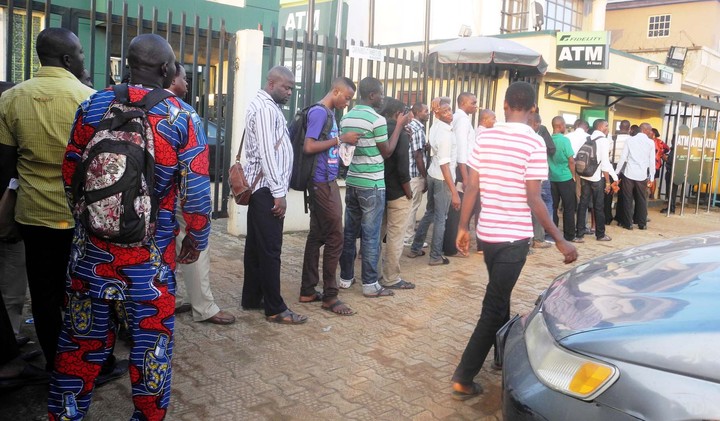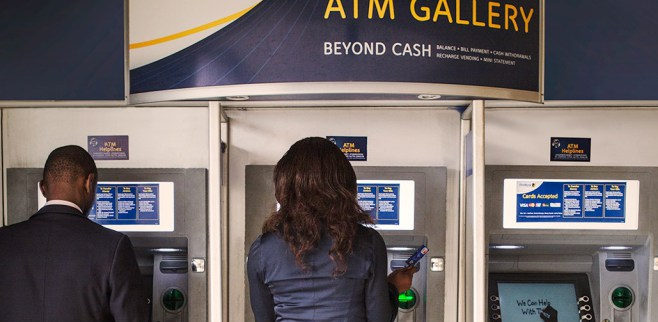By Austin Okere
“Bauchi Deputy Governor Can’t Access Cash At ATMs”, the headlines screamed on July 1, 2015. Apparently, there was no money in any of the three ATMs that the Deputy Governor tried, just to access N20k, according to a statement by the Permanent Secretary, Rabi’u Bello.
Automated Teller Machines are the most popular channel for bank customers. This is indeed a sad commentary for banks in Nigeria, especially against the backdrop of the recent NOI polls on Bank Financial Channels in the country, which revealed that ATMs were the most visible, proceed of the banking sector reforms to Nigerians.
According to the survey, of all the bank channels, customers used ATMs 68 per cent of the time compared to just six per cent for Internet Banking and six per cent for Point Of Sale terminals (PoS) respectively, with most customers using the ATMs more than once a week. The ATM has assumed great importance as the barometer of a bank’s brand as far as customers are concerned.
It is, therefore, difficult to phantom why banks have not taken advantage of this ubiquitous channel to enhance their brand value and gain customer loyalty.
Given that my company is an active player in the industry as a Value Added Reseller of Wincor-Nixdorf ATMs, I feel obligated to disclose my interest; but it is this same vantage position that affords me the insight to comment on this passionate issue bedeviling Nigeria’s bank customers.
The Six cardinal sins
In my view the unavailability of Banks’ ATM are predicated on six cardinal sins namely; suboptimal support strategy, low spread, low penetration, old systems, dirty and mutilated currency notes, and techies running the show instead of business savvy personnel.
Suboptimal Support Strategy
The major culprit of ATM unavailability is the suboptimal support strategy of most banks. They are suboptimal because they usually fall on the sword of ‘penny wise and pound foolish’. Consider the following scenarios; a situation where by merely installing appropriate monitoring tools provided by the manufacturers, ATMs can be remotely diagnosed and most times proactively, before a fault occurs. In this situation the fault can be trapped and fixed before it occurs, or in the case where a fault has occurred, the engineer appears at the site with the appropriate spare part, rather than make two trips, one to diagnose and the second to carry the right spare part to fix the problem. By saving on the investment on the monitoring tool, the bank is losing much more on the opportunity cost of unearned fees and more importantly, on brand impairment.

PIC.14. STUDENTS WAVING FLAG, DURING THE 53RD INDEPENDENCE CELEBRATION IN LAGOS
ON TUESDAY(1/10/13).
Most banks opt out of weekend support for ATMs in order to save support money. This is akin to cutting down on cleaning at the cinemas at the weekends. This is just so counter-intuitive. During the week, the ATM infrastructure benefits from the widespread support from the branches where they are located. The bank’s custodians ensure that the surround environment such as power and networks links are available, and any cash jam or out of service issue is quickly resolved or escalated to the support company.
It is during the weekend when that support structure is unavailable that ATM attendance is most required. And it is precisely this critical period that banks chooses not to support their ATMs in order to save cost. What ostensibly happens is that the ATMs breakdown, being mostly mechanical devices, and there is no opportunity for any call-out to repair them.
The ATM faults are piled up and reported en-block to the support company first thing on Monday morning, but they become overwhelmed because this bucks the trend of faults forecast under normal circumstances for which they would have been prepared. Being saddled with a ton of faulty ATMs simultaneously is not normal and inadvertently results in shortages of ATM Spares and long wait times. To compound issues, the banks typically do not make it easy for the support partners to have spares on hand by, insisting on maintenance payment in arrears. Maintenance payments in advance will greatly help sufficient spares procurement and readiness to attend to faults on time.
Another ‘catch 22’ situation in the support strategy relates to access of the ATMs for maintenance purposes during the weekend, in the few cases where banks have signed for weekend support. There is the dilemma of having the two people who each have an access key for the ATM, to both be on site, as the keys are simultaneously required to open the ATM from a security perspective. Many of the custodians live very far from the ATMs, which keys have been entrusted to them, and so there is an inherent wait time for them to make the long journey to the ATM to open it for the support personnel to have access for repairs, or even for cash loading in the case of cash out. It may be expedient to zone ATM keys to custodians who live close to the particular ATMs, or make adequate alternate arrangements.
Low Spread
The second cardinal sin is the poor distribution of ATMs across the country, with most of them concentrated around the 5,000 odd bank branches. Going by the statistics of the Central Bank of Nigeria (CBN) that there are 12,000 ATMs in Nigeria, and following the trend of at least two ATMs per branch, leaves only 2,000 ATMs to be distributed across all the other locations requiring cash dispensing in Nigeria. Typically, ATMs should be liberally placed around high footfall areas such as Malls, Markets, Petrol Stations, etc. The realities of distributing only 2,000 ATMs across all these areas are quite stark; not enough to go round. Barely enough to provide two ATMs each, for our 774 Local Government Areas.
Low Penetration
And this leads to the third cardinal sin, low penetration of ATMs where they exist. The story was told around Christmas of 2013, where the only ATMs that seemed to be working on the whole Gbagada axis were the couple at the Charlie Boy Bus stop. Of course the queue had built up to the extent that faint-hearted customers rather opted to go without cash than risk the possible consequences of a stampede. The problem could be solved by providing appropriate number of ATMs per location based on a study of the queues.
If the intention is to keep the customers from crowding the banking halls, it seems to me a circular argument bickering about the ATM and support costs, because this has to be compared against the cost of a bigger branch and more tellers, with their attendant salaries and benefits should the customers be compelled to go into a branch for lack of adequate ATM channels. The ATM penetration in Nigeria is about 11.4 ATMs per 100k adult population. Comparatively, Indonesia’s penetration of about 37 ATMs per 100k adult population is over three times that of Nigeria. South Africa has 60 ATMs per 100k adult population, while the UK has 124 ATMs per 100k adult population
Old systems
The fourth cardinal sin is over-flogging the ATM well past its ‘use by’ date. Many senior bank officials will typically have their official cars changed after every four years (the ATMs are much less than half the costs of the status cars of the banks’ middle management staff), yet even where statistics show that the cost of repair of a consistently failing old ATM is unsustainable and will be cheaper to replace, there is a deep reluctance to do so. This could perhaps be because the support partners aren’t given the opportunity of slab pricing, where they charge a higher support premium for very old systems. In the end, every shortcut gradually catches up with us. The system is just not able to perform the function for which it was procured, and the customers bear the brunch.
Dirty and Mutilated Currency notes
The fifth cardinal sin is loading the ATM cassettes with currency notes not fit for that purpose. While it is understandable that it is not possible to always have crisp notes in the ATM, every effort should be made to sort and aerate the notes going into the ATM to ensure that that they are fit for purpose, and do not cause cash jams, which throw the ATM out of service, notwithstanding the amount of cash in it. It is common knowledge that bank staff and their friends do somehow find crisp notes for ‘spraying’ at social functions at the weekends. These are the kind of notes that should be loaded into the ATMs and not the unfit ones that will quickly fill the ‘reject bin’ and render the ATM out of service.
Techies running the show instead of business savvy personnel
The sixth cardinal sin, which is not limited to banks, is the common mistake of promoting techies out of their area of competence and comfort to business managers. Techies should have their own growth tracks and should aspire to the highest specialist positions where they can continue to usefully contribute to the organization. Having said so, I have seen techies who have imbibed deep management skills and made the cross from the technical line to the business line.
These are indeed rare breeds, whose background in both technology and business help them to make better managers. But having pure techies run important businesses such as ensuring that the over 76 million Nigerian bank customers consistently have ATM availability, and the managerial intricacies that this will demand, is not fair to them, nor to the customers. In todays’ cashless Nigeria, e-Banking is going to be the key to the success or failure of a bank, based on her ability to retain customers. The need for this critical Division to be appropriately manned cannot be overemphasized.
If we get this right, then the deputy Governor, and indeed every bank customer will have the true benefit of the use of their ATM cards.





























